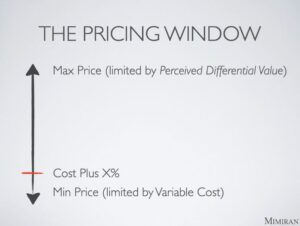Stop Commodifying Yourself

As part of our educational programs on pricing, we bring you a 4-part series from Reuben Swartz, who spent over a decade helping companies from Fortune 500 giants to independent consultants improve profits through better pricing. He also created Mimiran, the fun, “anti-CRM” for independent consultants who hate “selling”. He also hosts the Sales for Nerds podcast.
Stop Commodifying Yourself
Consultants suffer from an unfortunate tendency to commoditize themselves. (As David Newman says, prospects rarely even get the chance.) Why does this happen? What does it mean for your business? And, what can you do about it?
If you’re in professional services, it might seem obvious that what you sell is a service. But what are your clients buying? And where does that fit in the Value Ladder?
The Value Ladder
Commodity → Product → Service → Experience → Transformation
True commodities, like crude oil, have prices set by the market. You have no pricing power, except by altering supply and demand. Refining that commodity into a product provides some differentiation and pricing power, whose limits depend on the particular market.
Moving further up the value ladder into services, you have more differentiation and pricing power. Consider a consultant who helps companies implement a CRM product, for example. The client willingly pays extra to have someone handle some of the work.
At the next step, providing a great experience means more pricing power. Perhaps the consultant not only sets up the CRM, but writes the copy for the website, sets up the sales process, and handles introductory phone calls, only passing along qualified prospects.
At the highest level, you are not just providing something, you are transforming the client in a way that would not have been possible without you. Perhaps this means clarifying the client’s positioning so they can pursue more lucrative markets and increase profits not just by 20%, but by 1000%.
As we move up the ladder:
- Differentiation increases
- Market size decreases (you might think this is a negative, but it’s hugely positive)
- Pricing power increases
- Client respect increases
Just to be explicit, the converse is true, as well. As we move down the ladder:
- Differentiation decreases
- Market size increases
- Pricing power decreases
- Client respect decreases
As differentiation decreases, so does pricing power.
If we race to the bottom, there is no way to “make it up in volume”, and our attempts lead to burnout. We have to work more hours, for clients who respect us less.
Just to make the math simple, would you rather work 1,000 hours at $200/hr (not that we should be charging hourly, but we still have a certain amount of revenue for a certain amount of hours worked) or 2,000 hours at $100/hr? The overall revenue is the same, but which one would likely be more fun? Which one leaves more time and energy for other things, inside or outside the business? Which one lets you take on more additional clients?
Let’s take a look at our “pricing window”, the range of possible prices.

The maximum price we can charge is limited by Perceived Differential Value.
The minimum price is limited by variable costs, which for many consultants are quite low.
When we commoditize ourselves, we drive down the price ceiling, because we limit the perceived differential value.
With global competition, commoditized services have very low perceived differential value.
Perceived Differential Value
Why do I keep talking about Perceived Differential Value? Because value is only important when the prospect perceives it. You might think your service is worth a lot, but if the prospect doesn’t think so, it doesn’t matter.
The Differential part means that buyers are always comparing value to something else. It could be a direct competitor, an indirect competitor, or even just sticking with the status quo. You might offer great value, but if it’s the same as a competitor who charges half as much, that limits your pricing power.
Self-Commodification
The problem is rarely that clients don’t perceive your differential value. If they have a problem with your pricing being too high, they will tell you. In fact, getting regular price objections is a healthy buying signal. (It does not mean you need to lower your prices.
The typical problem is that the consultant self-commodifies.
Underestimating the value
Because they can perform their work with relative ease, they underestimate the value of the work. Just because you can update code for a website overnight, that doesn’t mean you offer a “cheap” solution.
Underestimating differentiation
And just because someone else can also update the website overnight, doesn’t mean that you don’t have differential value. There may be intangible benefits that you don’t see, but that are critical for the client- that you send regular status updates, for example, or that you push back on ideas that are possible but not optimal for the client.
You might think, “of course I would do that- wouldn’t anyone?” But not everyone does, and that may be what your client is really buying- the experience of getting their site updated and enjoying peace of mind, rather than the lower-value offerings of tasks done for pay.
Unwillingness to charge
Sometimes people understand the value they offer intellectually, but feel guilty about charging what they perceive as “too much”. Of course, buyers can tell us if they think we are too expensive. We don’t have to preemptively create those barriers in our own heads.
Avoiding Self-Commodification
Commodities are not differentiated. Transformations are extremely differentiated. (For example, doctors not only go to medical school, but highly paid surgeons then pursue fellowship programs. Turning a regular person into a neurosurgeon is a specialized transformation.)
Not every person in our general market will perceive the same value in our offering(s). So we want to start by focusing on those who perceive, and are happy and eager to pay for that value.
Too many consultants are “business doctors”. They treat any business symptom. When you’re on an airplane, and the flight attendant asks for a doctor, they’ll take anyone- they’re desperate. But your prospects are not desperate, they want the doctor who specializes in the particular kind of knee surgery that will help them get back on the ski slopes (or whatever their particular situation is). If it was your knee, or your business, do you want the doctor standing at the entrance to the hospital, saying “sure, I can do that, I studied knees in medical school”, or the doctor who does 20 of those procedures every week?
But people hate to get specific about their ideal prospects. Sure, you could help other people, if you’re stuck on an airplane, but why not aim for the best prospects, the ones who are able and eager to pay you, who call you to do your best work? You have limited time, and you will not be able to serve everyone, after all.
I think evolution wired us to resist narrowing our focus like this. We evolved for scarcity, not abundance. So when we try to niche down from “business doctor” to “family business succession planning doctor”, or whatever, our minds immediately conjure examples of businesses adjacent to our ideal prospects who we could help, or maybe even that we are helping now. How can we give them up?
First, consider that the ideal prospects- the repeat projects from past clients, the perfect referrals- don’t even seem to involve selling. Everything just flows naturally. Meanwhile, the less-than-ideal fits involve lots of back and forth, some convincing, often don’t sign up, and if they do, the projects cause a lot of stress and often regret. With limited time, where should we focus?
So instead of worrying about pursuing a smaller market by niching down, think about making sales and marketing easier, rather than harder. This is how I got around my evolutionary aversion to getting more focused. Unless you wish sales and marketing was more of a challenge, of course.
When you have that well-defined niche, you can differentiate more easily and avoid commoditization. Try disqualifying prospects out of your sales process, instead of talking people into it. This means that the people you work with are good fits, who want to be working with you. (We’ll get into this topic more in the next article.)
In addition, when you’re talking to prospects, don’t just ask questions about the commodity-level issues. These are the symptoms. Moving up the “pyramid”, you can ask business-level questions about the financial impact of the problem(s). This gets you out of commodity-level thinking and competition. But the next level, that provides not only more pricing power, but helps you best serve clients, is asking about how these issues impact them as a person (“life-level” questions.)
For example, a prospect might say they need help updating the website. If you say, “ok, great, I can do that”, you’re now a commodity amongst many. So you might ask:
- What is the impact of not having these updates?
- What have you tried in the past?
- Why did that not solve your problem?
- What is your timeline for achieving this solution?
Now you can not only charge higher fees, but you can provide better value because you understand the business context of the problem.
But you might go one step further, and ask questions such as:
- How does this project fit into your larger business goals?
- How will your life be different if we are successful?
- What does success mean to you for this project and in relation to your bigger goals?
Sometimes the answers are remarkably unremarkable. (“I want to be at my kid’s soccer game on Saturday instead of in the office.”) Sometimes they are more grandiose. (“I want to have 10 locations by the end of the next year and 40 by the end of the following year.”) But knowing how your project ties into not only business goals, but the buyer’s sense of identity lets your offer a great experience, and even a transformation, that removes the inclination to go for the lowest bidder, and instead go to the provider who can give them what they really need. And, it gives you the chance to not only make more money, but solve the real problem and do more meaningful work.
This leads us into our next article, coming up later this month, on how a healthy pipeline helps you price properly.
About the Author:

Reuben Swartz is the founder of Mimiran, the fun CRM for independent consultants who love serving clients but hate “selling”. He’s also the host and chief nerd on the Sales for Nerds podcast. He went from a background in computer science and software engineering to sales and marketing consulting for the Fortune 500, while struggling with sales and marketing for his own firm. His mission is to help other independent consultants make a bigger dent in the universe and get more clients by using their talents to teach instead of market, connect instead of network, and help instead of sell.
Categories
Subscribe to the Insights blog to get weekly insights on the next way of working
Join our marketplace to search for consulting projects with top companies
Learn more about MBO
Learn how to start, run and grow your business with expert insights from MBO Partners
Learn how to find, manage and retain top-tier independent talent for your independent workforce.
MBO Partners publishes influential reports, cited by government and other major media outlets.
Research and tools designed to uncover insights and develop groundbreaking solutions.


